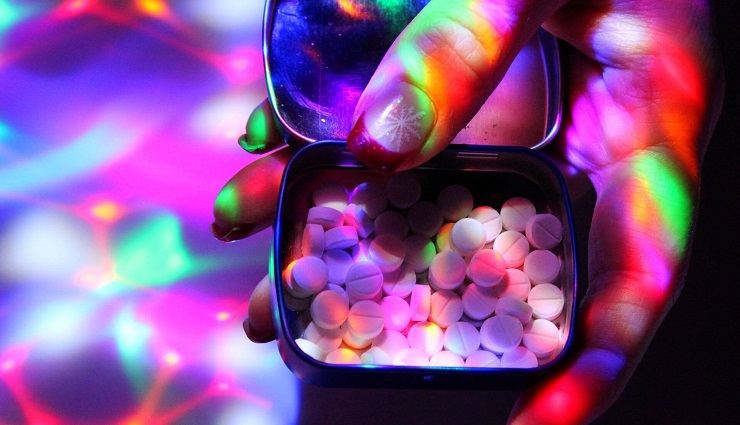Ecstasy is an illegal synthetic substance that increases the feeling of sympathy and affection for others and stimulates the nervous system. High doses can alter perception and cause a feeling of levitation, but they may also cause seizures and vomiting. Ecstasy sometimes causes death by inducing a heart attack, stroke, excessive body temperature increase, or excessive water consumption. If you want to know more about ecstasy, its effect on the body, the dangers of its use, and its medicinal uses stay with us.
What is MDMA or Ecstasy?
Ecstasy is a common name for an illegal substance called methylenedioxymethamphetamine (MDMA), sometimes called “molly.” This drug belongs to the category of empathogens; that is, it increases the feeling of sympathy and kindness to others. It may also be stimulant or energizing because it speeds up the central nervous system, can alter one’s perception of reality in high doses, and cause hallucinations. Ecstasy is usually used illegally at parties to improve mood. High doses of ecstasy may cause convulsions, vomiting, and even death.
This substance affects brain nerve cells that use serotonin to communicate with each other. Serotonin balance is essential in mood regulation, aggression, sexual activity, sleep, and pain sensitivity. Usually, young people and teenagers use this substance to create euphoria, a feeling of closeness, sympathy, and sexual desire. Also, this substance can have psychoactive properties like mescaline and LSD.
Ecstasy is usually taken in pill form but may also be in powder form. Tablets come in different colors and may have other images or logos engraved. The effects of this substance are often felt about 20 minutes to 1 hour after consumption and remain for 3 to 4 hours. X pills may take 1 to 2 days or even one week to wear off.
How is ecstasy used?

This substance was initially produced in Germany, but today it is paid for in illegal laboratories, which makes its dosage or contents unknown. Pills may be sold as ecstasy that contains no MDMA or other chemicals such as amphetamine, PMA, PMMA, ketamine, or even other filler compounds with unexpected side effects.
Ecstasy is usually made in tablet form (capsule or powdered tablet), but it may also be sold as a powder or crystal. Most people swallow the pill, but some inhale, snort, or inject it. It may also be consumed in liquid form. Usually, people who use this illegal substance combine it with other psychoactive substances such as LSD, alcohol, or marijuana.
Is ecstasy addictive?
Researchers do not yet know if this substance is addictive or not. Ecstasy affects the serotonin system, a chemical pathway that other addictive substances affect. A questionnaire was provided to young people and teenagers who used this substance, and it was found that 43% of them had symptoms of dependence and continued to use ecstasy despite being aware of its physical and psychological harm, the effects of withdrawal, and creating drug tolerance, and 34% had the same symptoms. They abused the substance.
About 60% of people who use ecstasy experience withdrawal symptoms such as:
- contusion
- loss of appetite;
- feeling depressed;
- Difficulty concentrating.
According to animal experiments, this substance is a type of narcotic and may affect the brain. According to clinical research, ecstasy may cause permanent or long-term memory and learning problems.
What effect does ecstasy have on the body?
People who regularly use ecstasy have poorer memory and mental performance than people who do not use this substance. Some of these effects may be due to using other compounds with this substance. According to research, high consumption of ecstasy can cause long-term memory problems.
Physical effects
High doses of ecstasy can disrupt the body’s ability to regulate temperature. For this reason, there is a possibility of dehydration. In rare and unpredictable circumstances, it may cause a severe increase in body temperature, leading to liver, kidney, and cardiovascular system failure and even death. Because this substance may disturb the metabolism, it may reach a dangerous level in the body by repeating the consumption of these substances in short intervals.
People who use ecstasy face the same risks as other stimulants, such as cocaine and amphetamines. These risks include increased heart rate and blood pressure, greater risk for people with cardiovascular disease, and other symptoms such as muscle cramps, involuntary teeth grinding, tremors, nausea, blurred vision, lethargy, earthquakes, and sweating.
Psychological effects
The psychological effects of ecstasy include confusion, depression, sleep problems, addiction, and severe anxiety. These symptoms can develop from taking joy to days and weeks after.
Neurotoxicity
According to animal testing, ecstasy use can cause long-term damage to nerve cells involved in mood, thinking, and judgment. Another experiment on hominids indicated that using this compound for only four days causes damage to the serotonin nerve endings and remains for 6-7 years. Although similar neurotoxicity has not been conclusively confirmed in humans, based on animal studies of its harmful effect, this substance is unsuitable for human use.
Contamination and hidden dangers
- Other chemically similar substances to ecstasies include MDA (methyldioxyamphetamine, from which joy is made) and PMA (paramethoxyamphetamine, which has caused deaths in the US and Australia) may be sold as ecstasy. These drugs cause neurotoxicity and endanger the user’s health.
- In addition to MDMA, ecstasy pills may contain compounds such as ketamine (an anesthetic commonly used in veterinary medicine), cathinone (e.g., bath salts), caffeine, cocaine, fentanyl, and methamphetamine.
- Although consuming this substance alone is also dangerous, some people unknowingly use it with marijuana or alcohol, putting themselves at greater risk.
Medical applications of ecstasy
Ecstasy has no approved medical use. According to research, possible benefits of MDMA include the following:
- post-traumatic stress disorder ( PTSD);
- anxiety in incurable diseases;
- social anxiety disorder ;
- eating disorders (such as anorexia nervosa or binge eating disorder) ;
- Alcohol addiction.
For people with post-traumatic stress disorder who use opioids, ecstasy is used in psychotherapy to produce rapid improvement.
A study was conducted on the effect of MDMA on patients who have post-traumatic stress disorder. This research gave three doses of ecstasy to 22 veterans, three firefighters, and a policeman with PTSD. 23% of these people had used ecstasy in the past. Also, this substance was combined with psychotherapy sessions. A month after the second session, many of those taking the high doses did not have PTSD.
After one year, 16 of the 26 participants no longer had this condition, but two were still diagnosed with PTSD. In addition, 12 patients were using other psychotherapeutic drugs. Side effects associated with all doses included anxiety, headache, bruising, muscle tension, insomnia, and suicidal thoughts.
Of course, not all experts were satisfied with this research, and there are still risks, such as addiction and suicide, in a society already exposed to these risks. Researchers believe that more 3-phase research should be done and that people with PTSD should only take this drug under the supervision of a psychiatrist.
Symptoms of ecstasy fade.
After experiencing the high of this illegal substance, coming off can be an unpleasant experience. These symptoms may last for several days and include:
- sleep disorder and bruising;
- muscle pain;
- anxiety, annoyance, and depression ;
- Concentration disorder.
Symptoms of an ecstasy overdose
If the dose of ecstasy is high or taken in large amounts, it is likely to cause a bad reaction or overdose. Consumers should watch out for these symptoms:
- convulsions and vomiting;
- The sudden and rapid increase in body temperature and blood pressure;
- dizziness and confusion;
- muscle spasms or cramps;
- Heart palpitations.
Injuries caused by ecstasy

Ecstasy can cause serious harm, including:
- Heart failure;
- stroke;
- Kidney failure;
- excessive increase in body temperature and dehydration;
- Drinking too much water.
Little research has been done on the long-term effects of ecstasy use, but some of the side effects include the following:
- permanent damage to brain cells that produce serotonin transporters (these cells play a role in regulating mood, body temperature, appetite, and libido);
- damage to the liver;
- memory and concentration problems;
- cold or flu;
- depression;
- Increased risk of AIDS, hepatitis, blood poisoning, or skin abscess if ecstasy is injected with a shared needle;
- Greater risk of unprotected sex, which increases the risk of sexually transmitted diseases ;
- Increased need for other substances such as benzodiazepines, alcohol, or marijuana to treat ecstasy side effects.
Ecstasy addiction treatment
The following methods can be used to treat the abuse of this illegal substance:
- Detoxification;
- individual counseling;
- group therapy
Support from similar people or talking to people in this situation can also be helpful. You can ask your doctor to refer you to the relevant centers.
I have frequently asked questions about ecstasy.
1. What are the other names of ecstasy?
The scientific name for ecstasy is MDMA, but it is also called Mali, XTC, and E. In Iran, this substance is known as X-pill.
2. Is ecstasy addictive?
Although the addictiveness of this substance has not been proven in research, there is a lot of evidence that it is addictive. Many of its users have said that it is difficult to stop taking it, and this can be due to psychological dependence. Also, like many other substances, ecstasy develops tolerance, meaning that a person needs to increase their intake to achieve the initial effect. Of course, this also increases the unpleasant side effects of the substance.
3. Does ecstasy have therapeutic uses?
Due to this substance’s severe and even fatal side effects, ecstasy is not widely used to treat mental disorders. Of course, there is research on its impact on post-traumatic stress disorder, anxiety, social anxiety, and eating disorders, but not enough to confirm its beneficial effects.
final word
Ecstasy is a stimulant and hallucinogenic substance that causes strong negative and positive emotions and unusual happiness. These effects last up to 6 hours, but ecstasy results can last for weeks. Long-term use can cause permanent or long-term brain damage and increases the risk of death from cardiac arrest or stroke. Ecstasy has few medicinal uses and is rarely prescribed by psychiatrists due to its many harms. This substance should never be used without a doctor’s supervision to treat complications such as post-traumatic stress disorder.
Warning! This article is only for educational purposes; to use it, it is necessary to consult a doctor or specialist.



